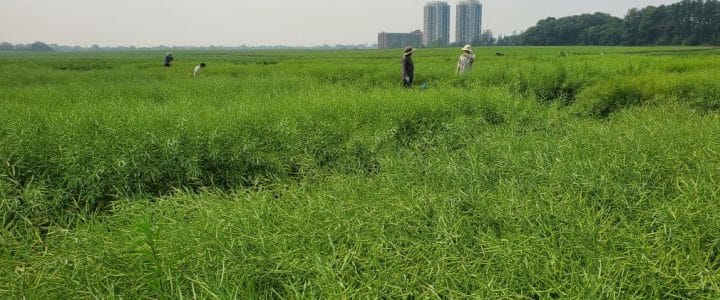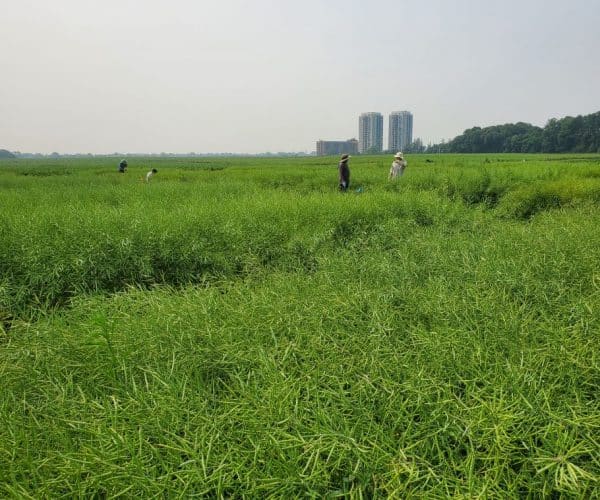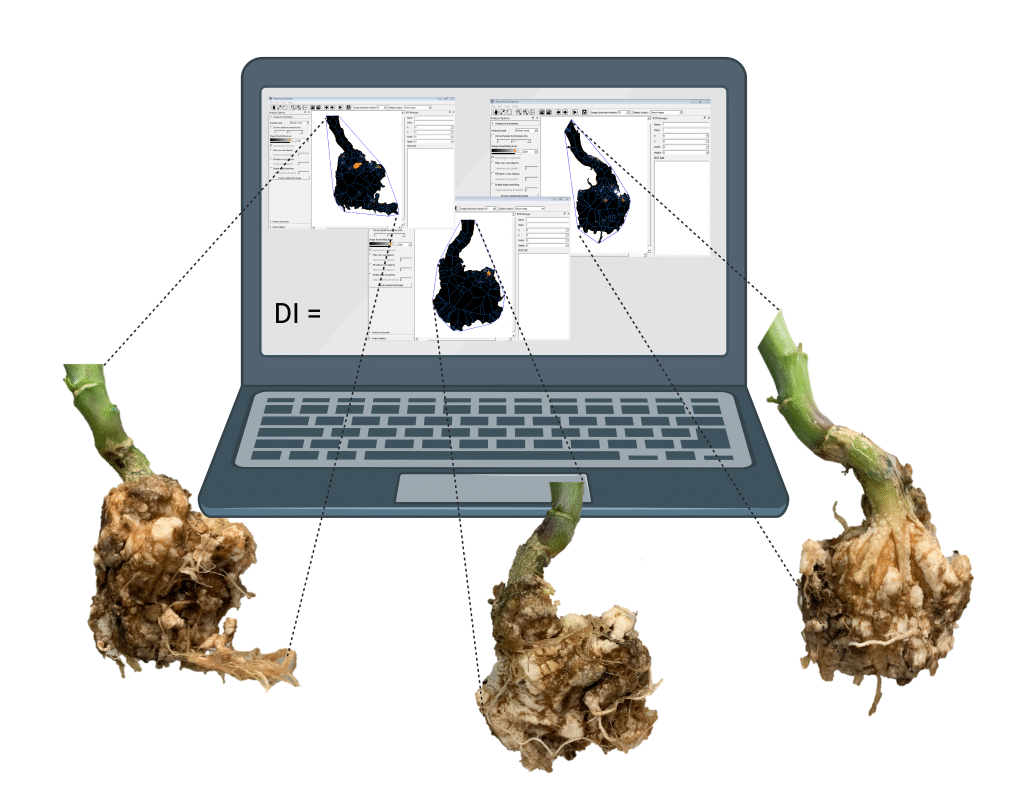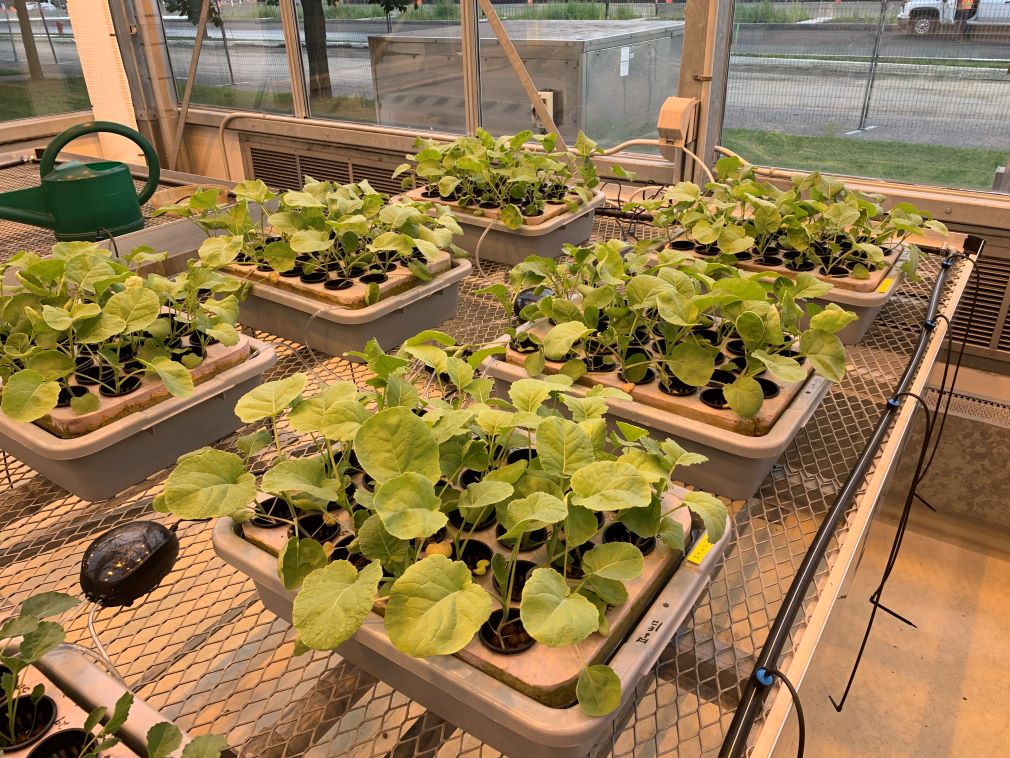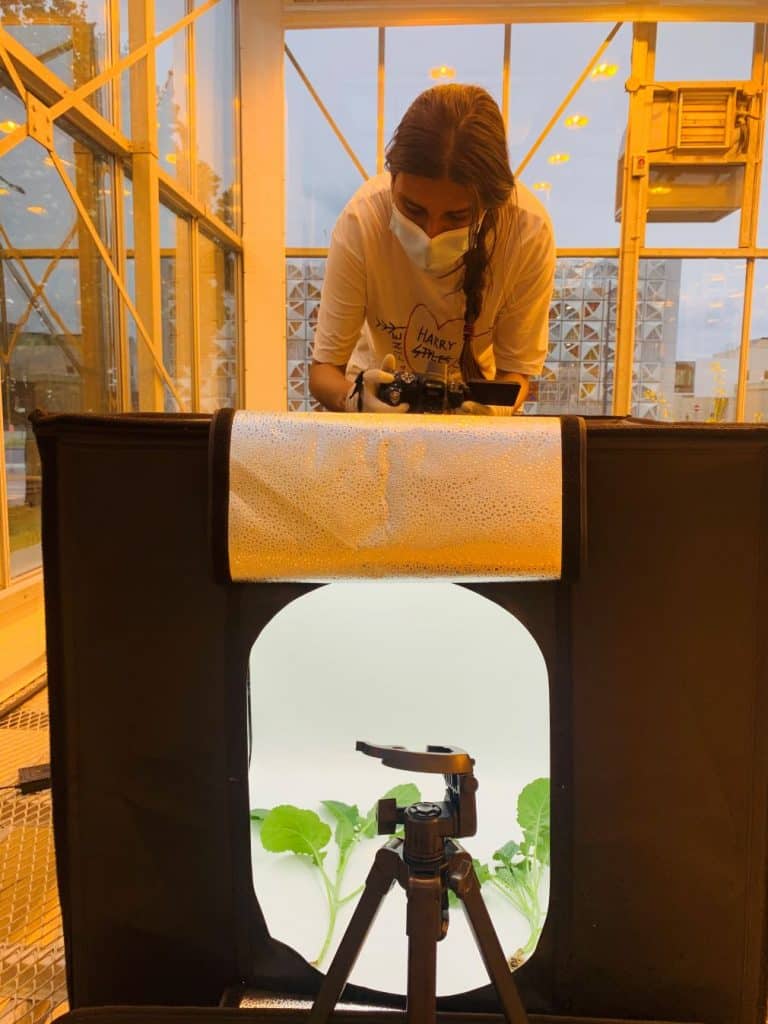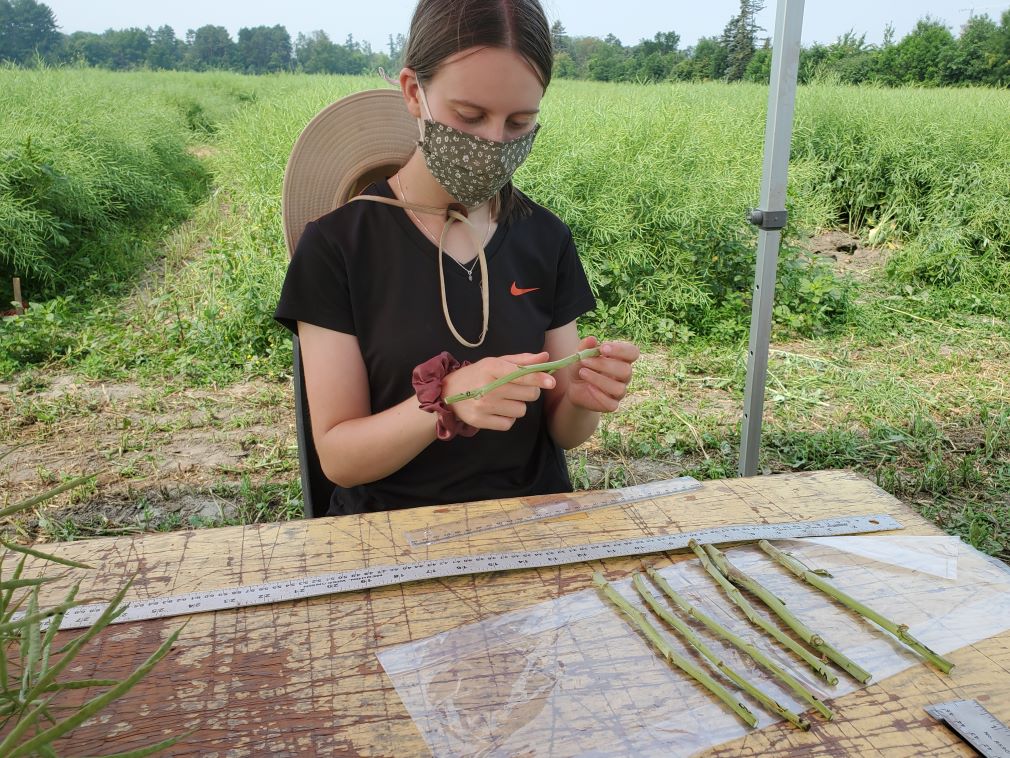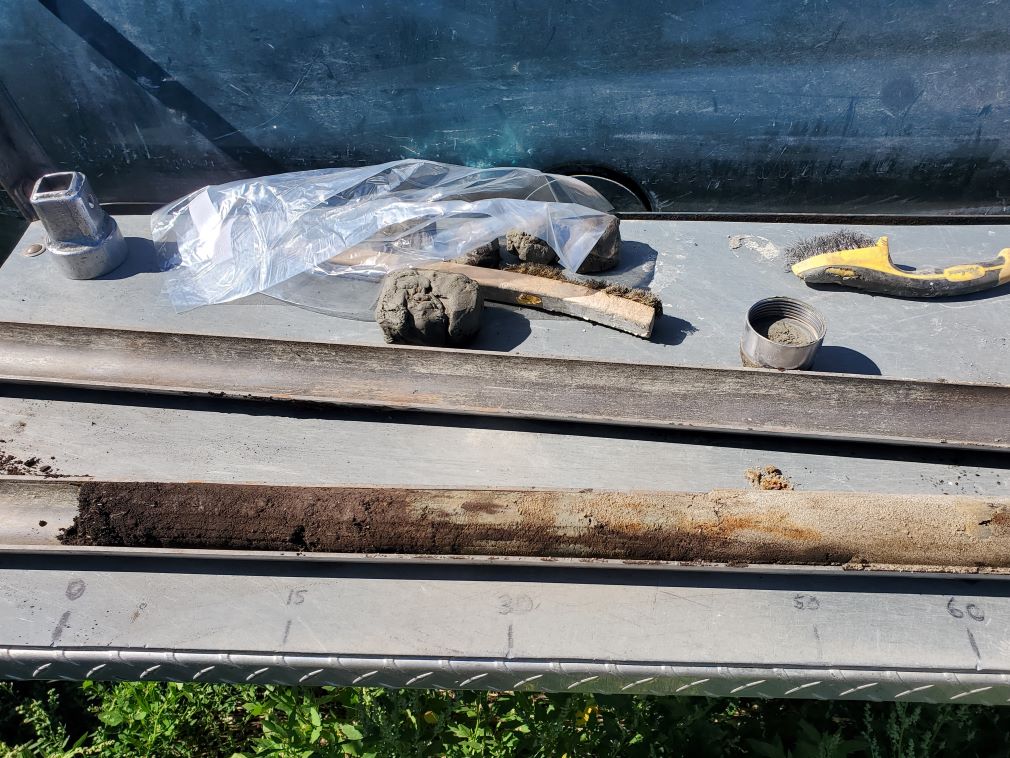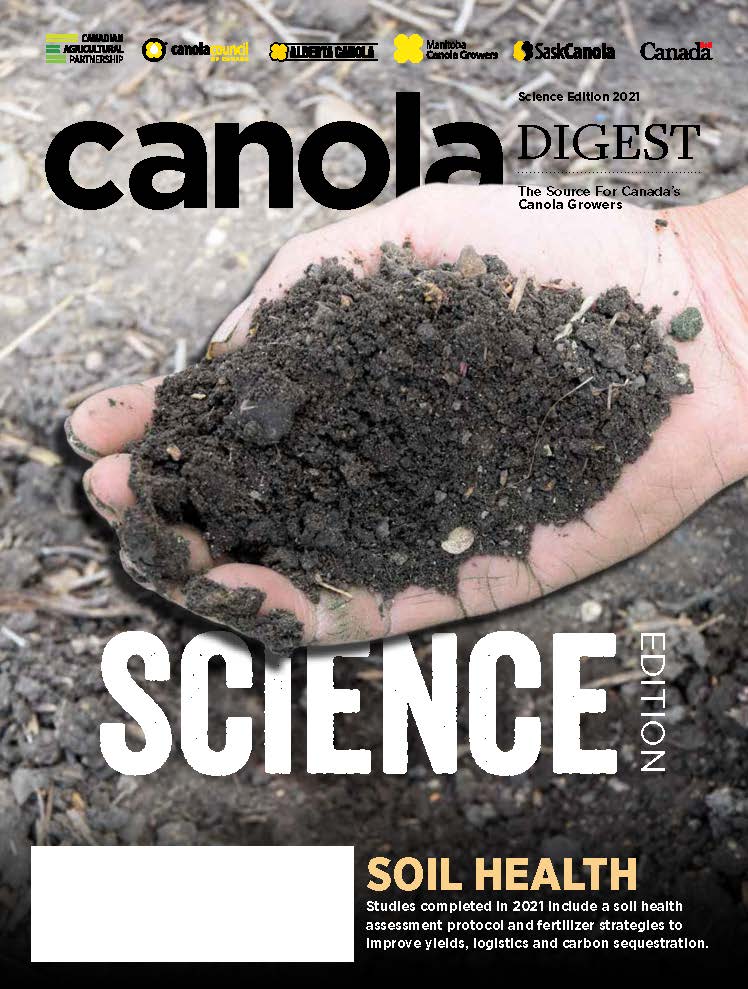Photo credit for feature image: Dr. BaoLuo Ma’s research team
Although the 2021 growing season was very challenging for many canola growers, several research projects were able to progress and wrap up. For an efficient year-end review, the outcomes of completed canola research projects are summarized in the 9th annual 2021 Canola Digest: Science Edition. This publication also includes brief updates on new and ongoing studies funded by SaskCanola, Alberta Canola and Manitoba Canola Growers through the Canola Agronomic Research Program (CARP), Canola Agricultural Partnership (CAP) on other initiatives.
2021 canola research outcomes
Key findings from research projects featured in the 2021 Canola Digest: Science Edition and posted on the Canola Research Hub include:
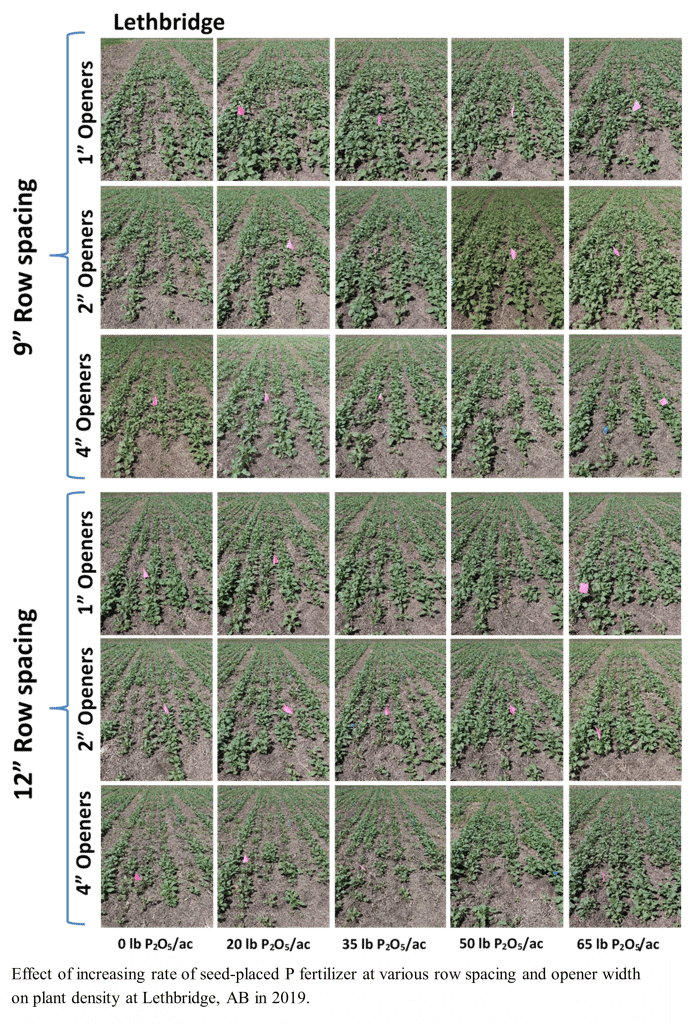
- Effect of cereal crop residue distribution on the following year’s canola emergence and yield
- A comparison of two choppers and three post-harvest residue treatments of wheat residue and reported no significant differences in canola emergence across treatments. However, the researcher still recommends proper residue management for a good canola plant stand.
- An on-farm approach to monitor and evaluate the interaction of management and environment on canola stand establishment and disease development
- This study found cultivar choice to be the most influential factor for canola emergence percentage. Seeding date also influenced emergence, but this was mainly a function of environmental conditions.
- All environmental variables influenced emergence, and temperature and heat units were consistently more influential than precipitation and moisture.
- This study found cultivar choice to be the most influential factor for canola emergence percentage. Seeding date also influenced emergence, but this was mainly a function of environmental conditions.
- Developing a soil health assessment protocol for Saskatchewan producers (Phase 1)
- Researchers created a Saskatchewan soil health assessment protocol with scoring functions, which provides the foundation for tools to transform a farmer’s routine soil test data into a Saskatchewan Soil Health Score. These scores can track soil health status over time, and can measure the effect of farm management on soil health status.
- Strategies to reduce fertility inputs and improve soil health and carbon sequestration in mixed crop-livestock systems
- This study compared seven cropping systems in year one, followed by canola in year two and wheat in year three. On a benefit:cost ratio basis, three treatments (year-one cattle manure, year-one green manure crop, and annual application of bio-stimulants) were reported to perform better than other cropping systems investigated in this study.
- Deep banding immobile nutrients under direct seeding systems to improve crop production and tackle nutrient stratification
- Overall, crop response was generally not linked to deep or shallow placement of phosphorus or potassium. Deep banding (5-6”) these nutrients at higher rates once every three years is an option if logistics make it a challenge to apply these products in a shallow band at the time of seeding.
- Reducing toxicity of seed-placed phosphorus fertilizer in canola
- Producers who are placing nitrogen (N) and sulphur (S) fertilizers away from the seed have more room to increase seed-placed phosphorus fertilizer without causing significant reduction in plant density and grain yield of canola. Opener configuration does not greatly influence phosphorus fertilizer recovery from seed-row placed phosphorus fertilizer.
- Validation of lygus and other insect pest thresholds in commercial farms throughout the Prairie Provinces
- This study validates a new threshold for lygus in canola. The general pattern is that abundances below two lygus per sweep do not reduce yield. Thus, the threshold of two to three lygus per sweep (20-30 per 10 sweeps) is recommended. Since current canola cultivars appear to tolerate lygus damage better than older cultivars, reducing this threshold as prices of canola increase is not recommended.
- Surveillance networks for beneficial insects: can natural habitats serve as insect reservoirs, and do they contribute to canola yield?
- The Beneficial Insects Surveillance Network collected evidence that beneficial arthropods found in non-crop areas do provide services to canola growers such as pest control and pollination.
- Utilizing this study, the lead research produced these related publications:
- Wild bee responses to cropland landscape complexity are temporally-variable and taxon-specific: Evidence from a highly replicated pseudo-experiment
- Non-crop sources of beneficial arthropods vary within-season across a prairie agroecosystem
- Pothole wetlands provide reservoir habitat for native bees in prairie croplands
- Landscape complexity is associated with crop yields across a large temperate grassland region
- If you are interested in this topic, check out the second phase of this project ‘Surveillance Networks for Beneficial Insects II: quantifying the canola yield effect of wetlands, shelterbelts and other insect reservoir habitats’ which began in 2019. It combines field experiments, the beneficial arthropod database, and precision agricultural data to further investigate the relationship between non-crop areas, arthropods and canola yield.
- Mitigating herbicide resistance – investigating novel integrated weed management systems
- Early application of integrated weed management (IWM) could be key because waiting until resistance establishes (and densities increase) could result in management failure and loss of control. Effective herbicides remain a critical part of integrated weed management. Steps taken now to increase diversity in the management strategy, while herbicides are still effective, is crucial to maintaining control of weed populations in the long term.
- While IWM systems can aid in management of the weeds, they are not a solution to herbicide resistance. But increasing diversity in the management strategy early, while herbicides are still effective, is crucial to maintaining control of our weed populations long term.
Active canola research projects
New and ongoing projects showcased in this Canola Digest: Science Edition’s section are also featured on the Hub.
One example is Dr. Pérez-López’s ‘Using avirulence markers to predict the phenotypes of clubroot pathotypes‘ study (pictured below). It is aimed at optimizing a hydroponic bioassay to phenotype the interaction between canola and P. brassicae, identifying P. brassicae avirulence markers, and designing and implementing a multiplex PCR assay able to differentiate P. brassicae isolates. The outcomes of this research will contribute to long-term management of the clubroot disease.
Another active project is Dr. Ma’s ‘Improving nitrogen use efficiency (NUE) and soil sustainability in canola production across Canada‘ project, which aims to develop best management technologies to promote canola productivity, profitability as well as sustaining the environment. This study includes two field experiments at eight locations across Canada and laboratory analysis. Photos of this project in progress are provided below, and as the feature photo of this blog.
Nutrient turnover and root-microbe interactions
Dr. Dumonceaux’s recently completed Canola frequency effects on nutrient turnover and root-microbe interactions project, which is mentioned in the 2021 Canola Digest: Science Edition, now has its final report featured on the Canola Research Hub, along concise summary.
Since crop rotation is an important strategy used by producers to maximize soil and plant health, this research examined canola root systems in rotations including canola; canola-wheat; and canola-pea-barley.
The results determined minimal impacts of rotation on root nutrient availability, however root exudate production was affected by continuous canola, resulting in differences in the fungal microbiome associated with canola roots.
The researchers also concluded that the soil and root-associated fungal microbiome responded more strongly to crop rotation compared to the bacterial communities, and identified a fungus, Olpidium brassicae, that was particularly dominant in the canola-only rotations. These findings highlight the importance of considering the effects of crop rotation on the whole plant, including its associated microbial partners, and point to new areas for future research.


Canola Digest: Science Editions
The 2021 Canola Digest: Science Edition was collaboratively funded by SaskCanola, Alberta Canola and Manitoba Canola Growers, along with the Canola Research Hub (which is funded by the Canadian Agricultural Partnership and the canola industry, including Alberta Canola, SaskCanola, Manitoba Canola Growers and the Canola Council of Canada).
In case you missed the previous versions, feel free to have a flip through these earlier Science Editions:
- Science Edition 2020
- Science Edition 2019
- Science Edition 2018
- Science Edition 2017
- Science Edition 2016
- Science Edition 2015
- Science Edition 2014
- Science Edition 2013
Read the full summaries, corresponding final reports and/or publications related to these research projects on the Canola Research Hub. In addition, check out the three provincial updates, Five CCC agronomy priorities article, two ‘Top 10’ articles and more, in the 2021 Edition!
Province-specific highlights
If you want to learn about the canola research funded by Manitoba, Saskatchewan and Alberta, check out the:
- Alberta Canola’s Research database
- Projects that Alberta Canola has provided funding support for, which are on the Hub, can be found here.
- Manitoba Canola Growers research database
- Studies that Manitoba Canola Growers has provided funding support for, which are on the Hub, can be found here.
- SaskCanola’s research projects reports
- Research that SaskCanola has provided funding support for, which are on the Hub, can be found here.
Alternative methods to improve agronomic knowledge
- To learn from live research updates and how they can be applied on farm, check out the monthly Canola Watch webinar series videos.
- Sign up for the annual Agronomy Update 2022 virtual event in January, 2022.
- For those who prefer listening to research summaries, check out this Canola Watch podcast, which features insight from Nicholas Larkin, Steven Strelkov and Sheau-Fang Hwang.
Additional canola research options
For a non-agronomic perspective on the canola industry, also check out:
- Canolamazing’s New research demonstrates increased milk production and reduced greenhouse gas emissions when dairy cows are fed canola meal
- CanolaInfo’s link to the Canola Council of Canada’s oil research directory
Published December 2, 2021


